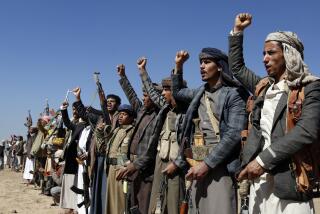Killing Al Qaeda’s leaders: It works
In the year since President Obama approved a successful raid against Osama bin Laden, public opinion has been shifting. While many Westerners still celebrate the targeted killing — along with the killing several months later of Anwar Awlaki — some are expressing doubts.
European politicians, human rights lawyers and members of some East Coast think tanks have posited that these terrorists were actually more dangerous dead than alive. Death, the reasoning goes, martyred the leaders, thus immortalizing their ideas and appeal. Furthermore, the critics say, killing Al Qaeda leaders has had little strategic effect because the group can quickly replenish its ranks with able deputies.
This is false. Though Al Qaeda finds it easy enough to replace mid-level commanders and foot soldiers, some of its top leaders are virtually irreplaceable. America has made great progress against Al Qaeda precisely because its strategy has been to go after high-value targets.
Take Bin Laden. The Al Qaeda leader possessed a combination of qualities that set him apart from all others in the wider jihadist movement. He had theological legitimacy, inspiring thousands of Muslims to fight and die on his behalf. And he was able to attract disparate jihadist groups into the Al Qaeda tent, including Egyptian Islamic Jihad, the Salafist Group for Preaching and Combat, and Jama’at al-Tawhid wal-Jihad.
Bin Laden built his military credibility in Afghanistan, where he provided economic and tactical support to the mujahedin during the 1980s and oversaw the creation of jihadist training camps during the 1990s. What cemented Bin Laden’s reputation, though, was the trio of devastating attacks on U.S. targets he orchestrated: the East African embassy bombings in August 1998, the bombing of the destroyer Cole in 2000 and the Sept. 11 attacks in New York and Washington.
While in hiding after the attacks, Bin Laden remained fixated on striking the U.S. again. He clearly understood that for his group to retain transnational relevance and potency, it could not restrict its operations to the Middle East. It is unclear whether Bin Laden’s replacement, Ayman Zawahiri, places as much priority on this.
Bin Laden is simply not replaceable. The idea that Obama made a strategic misstep by killing a man responsible for the death of thousands of U.S. citizens and committed to killing thousands more is absurd. Rather than making him a martyr, Bin Laden’s killing demonstrated that he was, like the rest of us, mortal. And it warned terrorists everywhere that targeting U.S. citizens will bring retribution.
The killing of Awlaki, an American citizen, further illustrates why targeting certain Al Qaeda leaders is an excellent strategy. Operationally, Awlaki was not a huge loss to Al Qaeda. He had no military reputation to speak of. But he was an eloquent English-speaking lecturer, able to effectively reach out to Western Muslims and urge them to attack their homelands. He provided theological justification for jihad to the failed Christmas Day bomber Umar Farouk Abdulmutallab, and he was in direct email contact with the Ft. Hood shooter Nidal Malik Hasan. There is no Awlaki replacement within Al Qaeda’s ranks. His death in September 2011 has, at least for now, limited the group’s ability to get persuasive messages out to Western Muslims.
Khalid Shaikh Mohammed, who was captured in 2003 and is imprisoned at Guantanamo Bay, is proof that the detention of high-value targets, though not always possible, is also an effective counter-terrorism measure. Al Qaeda was so reliant on Mohammed’s plans that variations of attacks he thought up in the early 1990s were being implemented as late as 2006. His reputation among jihadists for having conceived and coordinated the Sept. 11 attacks hasn’t been rivaled, and taking him out of action dealt a devastating blow to Al Qaeda.
Moreover, there is a cumulative effect. Removing so many key players has caused a creative stagnation within Al Qaeda that has been only partly offset by the growth of Al Qaeda in Yemen. That group has been increasingly active in recent years, attempting to bring down planes by placing a bomb in the underwear of Abdulmutallab in 2009 and by using explosives concealed in printer cartridges in 2010. Both plots apparently unfolded without U.S. intelligence discovering them, yet neither succeeded in taking lives.
This month, the U.S. foiled another bomb plot emanating from Yemen. Ibrahim Hassan Asiri (described by one former CIA officer as Al Qaeda’s genius bomb-maker) had constructed a device aimed at defeating new airport precautions. Asiri was also responsible for the underwear bomb used by Abdulmutallab. Because Asiri has undoubtedly passed instruction on to others, killing him would not entirely eradicate the threat, but it would be a good start. There is every reason for the U.S to target him.
Killing senior Al Qaeda leaders doesn’t just remove enemies from the battlefield; it also erases institutional knowledge and experience. Some followers may consider the targeted leaders to be martyrs. But that doesn’t change the fact that their deaths are bad for Al Qaeda. By killing the group’s elite leaders, the U.S. is not contributing to Al Qaeda’s mythology but destroying it.
Robin Simcox is research fellow at the Henry Jackson Society in London and the coauthor of “Islamist Terrorism: The British Connections.”
More to Read
A cure for the common opinion
Get thought-provoking perspectives with our weekly newsletter.
You may occasionally receive promotional content from the Los Angeles Times.






